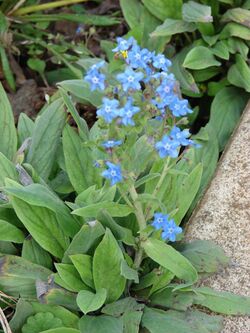Biology:Cynoglossum amabile
From HandWiki
Short description: Species of flowering plant
| Cynoglossum amabile | |
|---|---|

| |
| Scientific classification | |
| Kingdom: | Plantae |
| Clade: | Tracheophytes |
| Clade: | Angiosperms |
| Clade: | Eudicots |
| Clade: | Asterids |
| Order: | Boraginales |
| Family: | Boraginaceae |
| Genus: | Cynoglossum |
| Species: | C. amabile
|
| Binomial name | |
| Cynoglossum amabile Stapf & J.R.Drumm.
| |
Cynoglossum amabile, the Chinese hound's tongue[1] or Chinese forget-me-not, is a species of flowering plant in the family Boraginaceae, native to Asia.[2] A hardy annual growing to 50 cm (20 in), it has hairy leaves and cymes of sky-blue flowers in late summer. This plant, closely related to the common forget-me-not of temperate gardens (Myosotis sylvatica), is also grown as an ornamental.[3] In cultivation in the United Kingdom it has gained the Royal Horticultural Society’s Award of Garden Merit.[4] (confirmed 2017).[5]
The Latin specific epithet amabile means “lovely”.[6]
Toxicity
Cynoglossum amabile contains tumorigenic pyrrolizidine alkaloids[7] such as amabiline.[8]
References
- ↑ Cynoglossum amabile at USDA PLANTS Database
- ↑ {{citation | mode = cs1 | title = Cynoglossum amabile | work = Germplasm Resources Information Network (GRIN) | url = | publisher = [[Organization:Agricultural Research ServAgricultural Research Service (ARS), United States Department of Agriculture (USDA) | access-date = 16 January 2018 }}
- ↑ "Cynoglossum amabile at NC State University". http://www.ces.ncsu.edu/depts/hort/consumer/factsheets/annuals/chineseforgetmenot.html.
- ↑ "Cynoglossum amabile - Chinese forget-me-not". Royal Horticultural Society. https://www.rhs.org.uk/Plants/5194/Cynoglossum-amabile/Details. Retrieved 15 August 2018.
- ↑ "AGM Plants - Ornamental". Royal Horticultural Society. July 2017. p. 26. https://www.rhs.org.uk/plants/pdfs/agm-lists/agm-ornamentals.pdf. Retrieved 24 January 2018.
- ↑ Harrison, Lorraine (2012). RHS Latin for Gardeners. United Kingdom: Mitchell Beazley. ISBN 978-1845337315.
- ↑ Fu, Peter P.; Yang, Ya-Chen; Xia, Qingsu; Chou, M.W.; Cui, Y.Y.; Lin, G. (2002). "Pyrrolizidine alkaloids - tumorigenic components in Chinese herbal medicines and dietary supplements". Journal of Food and Drug Analysis 10 (4): 198–211. http://www.fda.gov.tw/EN/publishJFDAListContent.aspx?id=32. Retrieved 2018-08-15.
- ↑ Culvenor, CCJ; Smith, LW (1967). "The alkaloids of Cynoglossum australe R.Br. And C. Amabile Stapf & Drummond". Australian Journal of Chemistry 20 (11): 2499. doi:10.1071/CH9672499.
Wikidata ☰ Q2564008 entry
 |

